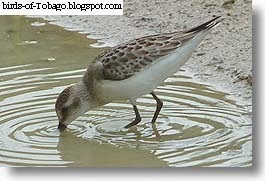 |
| Tropical Mockingbird (Mimus gilvus) |
Order : Passeriformes
Also known as Passerines or perching birds. Any member of the largest avian order which includes more than 5,700 species, more than half of all living birds. Passerines are true perching birds with four toed feet, three toes facing forward and one larger toe facing backwards.
Family : Mockingbirds (Mimidae)
The mimidae family consists of about 34 species in 10 genera including Thrashers, Tremblers and Mockingbirds. The Mockingbird accounting for about 17 species in 4 genera. These birds are noted for their remarkable ability to mimic a wide variety of other birds and other outdoor sounds. They are confined to the New World and tend to be dull grey or brown in appearance.
Name : Tropical Mockingbird (Mimus gilvus)
Length : 25 cm ( 10 in )
Local Names : Mockingbird, Day Clean
The Tropical Mockingbird is grey above with dark eye-steaks and whitish below, with a long white-tipped tail. It builds a rough nest of twigs in a bush or tree and is aggressively territorial while rearing it’s chicks, chasing off any bird that enters it’s territory with determination. They feed mainly on insects which they hunt in low bush or from the ground where they will open their wings causing a sudden shadow, grabbing any insects that instinctively move. They will also eat fruits and some berries. The Tropical Mockingbird is widespread in suburban areas, cultivated land, open countryside and forest edges, ranging through the West Indies, Central and South America.
#Tropical Mockingbird #Mimus gilvus #Mockingbirds #Mimidae #Passeriformes #birds of the West Indies #birds of Trinidad & Tobago #Birds of Tobago #birds
Bird identification images





























